In this series of articles on Galápagos animals I have so far covered Darwin’s finches, giant tortoises, endemic land birds, and endemic sea birds. Next, I will look at three fabulous species of Galápagos sea birds that are classified as subspecies endemic to the islands. The terms “subspecies endemic” mean that the animals (birds in this instance) are found only in the Galápagos, but other closely related members of the species are found elsewhere. The subspecies sea birds under consideration here are Galápagos boobies, brown pelicans, and frigatebirds.
Boobies:
In English the word booby means a fool or a nitwit. Various authorities attribute the boobies name to the Spanish word bobo which means a fool or clown. In the case of the Galápagos birds the names have been applied because they are so very entertaining. Every visitor to the islands desires to watch them demonstrate their plunge-diving abilities and their dance-like mating rituals.
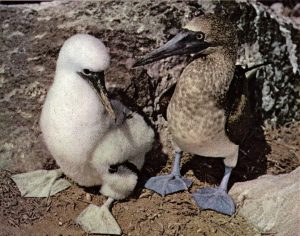 Galápagos Blue-Footed Boobies (Moore)
Galápagos Blue-Footed Boobies (Moore)
There are three varieties of the boobies on the islands, the blue-footed (Sula nebouxii), red-footed (Sula sula), and masked (Sula dactylatra). All are members of the same family as the gannets (Sulidae). Boobies can feed miles from shore eating mostly fish. With forward-pointing stereoscopic vision they can accurately pinpoint a fish (even when underwater) when they are high in the sky overhead. They then dive downward at up to 60 miles per hour and grab the prey before it has time to move. The boobies generally will swallow the prey while still underwater so there is less chance of another bird like a frigatebird stealing the meal.
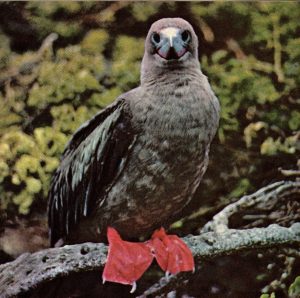 Galápagos Red-Footed Booby (Moore)
Galápagos Red-Footed Booby (Moore)
The blue, red, and masked varieties are similar in many ways of course, but their habits for nesting, mating, and fishing do vary by variety. The bright foot colors are the result of both pigment and the structure of collagen fibers beneath the skin. In the blue-footed boobies the brightness of the feet can vary due to illness. A female that detects such a lack of foot brightness in a male may choose to avoid mating with him.
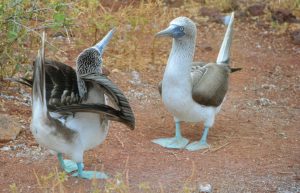 Courtship Antics of Two Blue-Footed Boobies (Davis)
Courtship Antics of Two Blue-Footed Boobies (Davis)
Brown Pelicans:
The Brown Pelican (Pelecanus occidentalis) is common around the coasts of the Galápagos Islands. They are large but lightly constructed birds often seen in anchorages where they wait to be fed scraps by fishermen. When flying above the ocean they perform what is called “shallow plunge diving.” In this operation they apparently clumsily, but efficiently, dive awkwardly into the water with a huge splash and gulp a pouch full of water that they anticipate includes a fish or two. Being very buoyant due to their body’s air-filled construction, they quickly pop back up and let the two to three gallons of water drain out of their pouch and immediately swallow any of the fish remaining in the pouch. Even with no fossil or genetic evidence evolutionists like to postulate that the pelican’s pouch evolved to keep other birds from stealing the fish they may catch. I would postulate that in the beginning the original pelican kind was created with this pouch design.
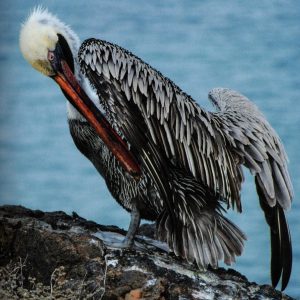 Galápagos Brown Pelican (Davis)
Galápagos Brown Pelican (Davis)
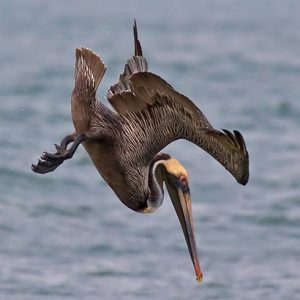 Brown Pelican Plunge Diving (Zeiler)
Brown Pelican Plunge Diving (Zeiler)
Here in Oregon where I live, Pelecanus occidentalis that are related to those in the Galápagos can be found along the coast. I was fortunate to be able to see and photograph a pair of these beautiful Brown Pelicans at the Oregon Aquarium in Newport in 2016 when they were being cared for after they had been injured and were nearly ready for reintroduction into the wild.
 Brown Pelican at Newport Aquarium in 2016
Brown Pelican at Newport Aquarium in 2016
Frigatebirds:
There are five species of frigatebirds that exist at various locations throughout the world. In the Galápagos there are two species, the Magnificent Frigatebird (Fregata magnificens) and the Great Frigatebird (Fregata minor). The Magnificent species is up to three feet long with a wingspan of nearly eight feet. Both species are known as “man of war” birds due to their propensity for stealing other birds’ food. Their aerodynamic design is spectacular as they have the largest wingspan-to-bodyweight ratio of any bird which contributes to their very acrobatic flying capability. In fact, anecdotal reports tell of the frigatebirds’ ability to catch boobies and other birds by their tails in mid-air, hold them upside down until they empty their gullets, and then catch the disgorged food before it hits the earth below. However, frigatebirds are perfectly capable of getting their own food without resorting to thievery.
The male is entirely black with a purplish sheen on its back and a red throat pouch. The female is somewhat larger than the male and is also black except for a white breast and shoulders. The female Magnificent has a blue eye-ring while the female Great has a red eye-ring.
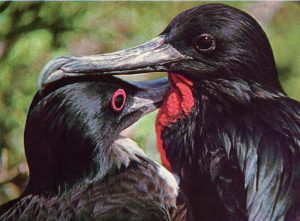 Female and Male Galápagos Great Frigatebirds (Moore)
Female and Male Galápagos Great Frigatebirds (Moore)
God has designed many exceptional methods for male birds to attract their females for mating, none more manifest than with the frigatebirds. When ready to mate the male finds a place to nest. Then he begins inflating his red throat pouch until it is the size of a beachball. This operation takes about 20 minutes. When an adult female of his species happens by, he erupts into a fit of headshaking and vibrating along with an explosion into a high-pitched shriek. This very conspicuous action eventually results in a single white egg being laid on a poorly constructed nest. Both adults help incubate the egg for about ten days. The resulting frigatebird chick is dependent on the adults for protection and food for a year or more and that precludes more than one chick per pair every two years.
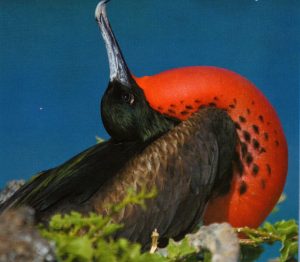 Galápagos Frigatebird with Expanded Throat Pouch Display (Davis)
Galápagos Frigatebird with Expanded Throat Pouch Display (Davis)
This concludes the series on Galápagos endemic birds. There is no wonder that visits to the islands are reported as always so unforgettable.
J.D. Mitchell
Related Articles:


